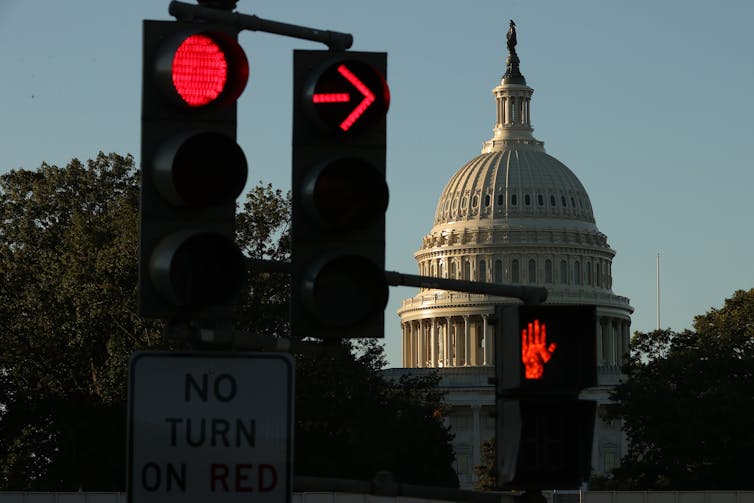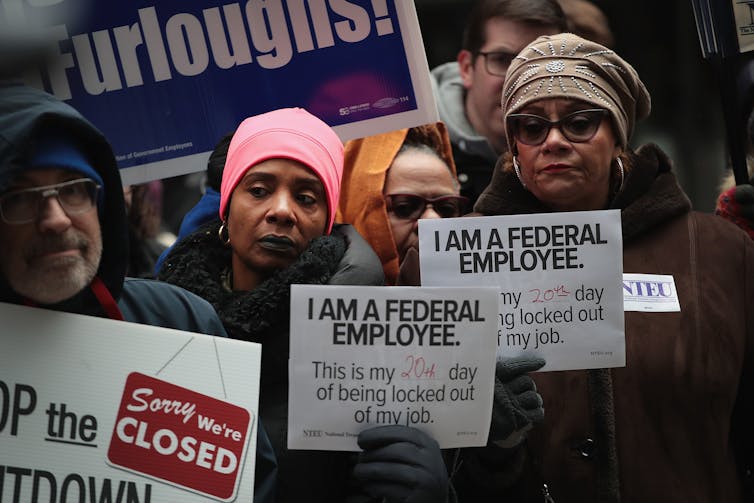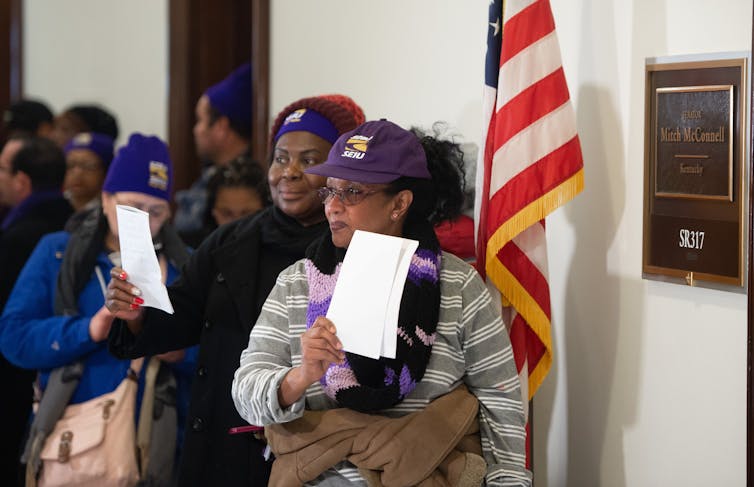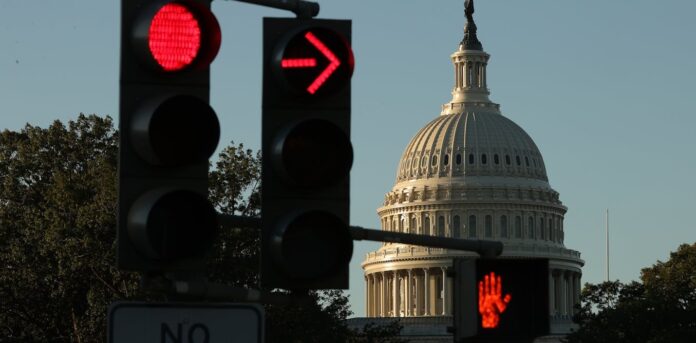Government shutdowns hurt federal worker morale, long after paychecks resume − especially for those considered ‘nonessential’

By Susannah Bruns Ali, Florida International University
Unless Congress and the White House can agree on a budget or extend funding short term, the federal government will shut down on Oct. 1, 2023.
This means that approximately 2.2 million civilian federal employees would be furloughed and face delayed paychecks and lost work hours – in addition to 3.7 million federal contractors who would also be forced to stop working and forgo their pay.
I am a scholar of public administration with a focus on government employees’ career paths. Much of my research centers on how turbulent politics filter into career employees’ daily lives, influencing their choices to join, stay with or leave the government workforce.
People don’t leave government because of a single event like a shutdown.
But negative experiences accumulate over time.
Shutdowns lead to more people being more likely to leave government employment – and higher workloads and lower motivation for those who remain. These conditions may feed Republican political goals, but they harm the millions of Americans who depend on competent, timely assistance from the public servants on the government payroll. This ultimately leads to lower work performance and employee retention problems.
My interviews with federal employees show that some will consider leaving if they are told that their work is not essential, they face financial stress or they don’t have a big enough project budget to do their job.
I have found that politicians and other people deriding government employees’ work is another factor that can push them to look for work elsewhere.

Financial stresses
The first U.S. government shutdown happened in 1976. Since then, the government has experienced 21 shutdowns.
The shortest shutdown lasted only a day, and the longest – and most recent – in 2019 was 35 days. The average shutdown is 7.6 days if all shutdowns are included. If you exclude the record-setting eight consecutive short shutdowns in 1981, the average length is 11.2 days.
These shutdowns are often expensive. The U.S. Congressional Budget Office estimated that one 35-day shutdown, from December 2018 to January 2019, cost the U.S. economy over US$3 billion, given the loss of federal workers’ contributions to the economy and other factors.
But federal employees and contractors – people who work for the government, though not in a full-time, salaried capacity – feel the worst effects of a government shutdown.
Essential and nonessential workers
Almost all civilian federal employees – with the exception of U.S. Postal Service workers – do not receive paychecks when the government is closed, regardless of whether federal agencies determine their work is considered “essential” or “nonessential.”
A large range of employees, from National Park rangers to medical researchers, are typically considered nonessential and stay home during a shutdown. Essential workers who must stay on the job could include law enforcement officials and federal prison guards.
Both nonessential and essential workers, whether they are working during a shutdown or not, won’t get paid until after the shutdown ends.
Even short delays in pay can have substantial financial effects.
In 2017, a quarter of the federal workforce made less than $56,143 a year, and the median salary was $79,386. Some of these workers live paycheck to paycheck.
My research shows this gap in pay can leave people unable to pay their rent or mortgages and can also lead to difficulty paying for everyday expenses like groceries.
Many end up depending on food banks and other resources to bridge the gap between paychecks. Federal workers like administrative assistants or security guards who receive lower wages, or young workers who haven’t built up financial reserves, are the first affected.
Different results for employees
Workers who are considered “essential” must work through a shutdown without receiving pay until after the government reopens. Their “nonessential” peers are not allowed to do any work, also without receiving their salary until the government reopens.
Contractors will not be allowed to work during a shutdown and will never receive any compensation.
But contractors and federal employees are often working in the same office. They are functionally co-workers who know that some will be paid and others will not if a shutdown happens.
Individual managers make the decision about which employees are “essential” and which are not.
Some managers use the work itself to guide their choices, while others may look at fairness concerns and individual employee circumstances, like how long someone has been on the job.
Inconsistency in these decisions leaves room for tensions over fairness.

‘Really offended’
My research shows that a discrepancy in how workers are treated during a shutdown can create workplace conflicts. As a result, employees can wind up feeling low morale, which reduces work productivity.
One federal worker I interviewed following a two-week shutdown in 2013 said: “Up to September 30th we were working 10-hour days. On October 1st we were nonessential.”
Another furloughed employee explained why the division between employees who were asked to continue working or stay home during a shutdown made some people upset.
“We had to put together two lists: mission essential and not. People who were not essential were really offended thinking that others thought what they did was not important. That government shutdown had a greater effect than what I thought it was going to have on the workforce,” this employee explained.
A loss for the workforce
Shutdowns have other hidden costs that could undermine the federal workforce’s strength.
In 2017, about 45% of federal employees were older than 50, while only 6% were younger than 30.
If a wave of future retirements leaves a smaller pool of workers who are questioning their careers in government, this could weaken the federal workforce and its performance.
Shutdowns become a part of workers’ decision-making process about their career paths.
My research shows that workers at the beginning of their careers are more likely to change jobs than colleagues who have been there longer.
Many people I have interviewed also say that the strain of shutdowns made them consider retiring earlier instead of waiting a few more years.
Long-term damage
Conservative politicians have long advocated for reducing the size of the federal government. Then-President Ronald Reagan succinctly made this point in 1981, when he said, “Government is not the solution to our problem, government is the problem.”
If one views government and spending as fundamentally flawed, then taking drastic action to reduce spending and even shutting down the government becomes a viable path for achieving policy goals and political points.
The problem is that shutting down government is expensive and causes long-term damage.
By authorizing a shutdown, elected officials are signaling in concrete ways that the work of the federal government and its employees is not valued. And regular Americans rely on federal employees to do quality work for all sorts of things, including maintaining national park monuments, inspecting hazardous waste sites and monitoring drinking water facilities.
Even if public proclamations about firing federal employees and “draining the swamp” are not acted on, they could make anyone interested in federal service think twice.
I think people need to recognize that government shutdowns have a price that is far greater than a temporary disruption.![]()
Susannah Bruns Ali, Assistant Professor of Public Policy and Administration, Florida International University
This article is republished from The Conversation under a Creative Commons license. Read the original article.



